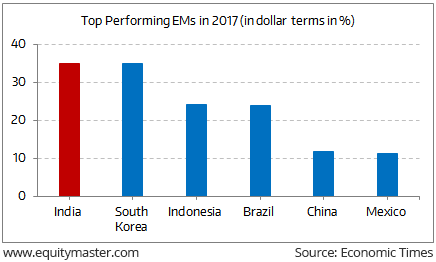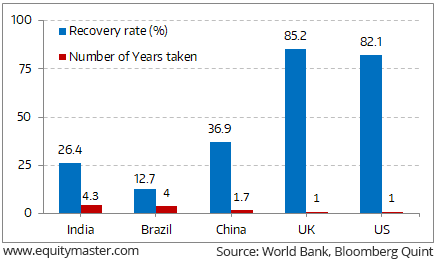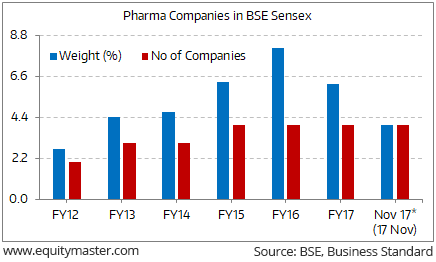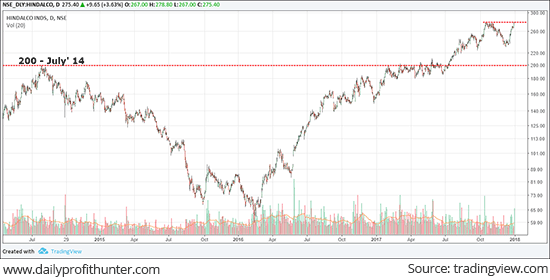Majority of the Asian stock markets are closed on account of new year eve. The US stock indices slid into negative territory on Friday as trading activity remained light for the day. The Dow Jones Industrial Average lost 118 points, the Nasdaq edged down 47 points and the S&P 500 dropped 14 points.
Back home, India share markets began the New Year on a flat note. The BSE Sensex is trading higher by 33 points while the NSE Nifty is trading higher by 3 points. The BSE Mid Cap index and BSE Small Cap index opened the day up by 0.3% & 0.4% respectively.
Barring IT stocks, all sectoral indices have opened the day in green with capital goods stocks and realty stocks witnessing maximum buying interest. The rupee is trading at 63.93 to the US$.
2017. What a year this has been for equity investors. The BSE Sensex is trading close to 34,000 mark. The Nifty is trading above 10,500 levels.
India was among the three emerging markets, which gained more than 35% in dollar terms. The other two are Hungary and South Korea.
The BSE Sensex earned a 35.1% return in the dollar terms and 28% in the local currency in 2017. However, this wasn't enough to beat the midcap and smallcap indices. The midcap and smallcap indices saw a sharp increase of 47% and 58% respectively in 2017.
With this, the market cap to GDP ratio is close to 100%, indicating market at its peak. So, how will 2018 turn out? Here's what Tanushree Banerjee, Co-head of Research thinks:
- "In 2018, the market would be more volatile and under pressure. Investors should brace themselves for the increasing volatility. Although, earnings are likely to recover, profit margins could get squeezed as companies face rising input cost pressures. Rising oil prices may prompt the government to abandon fiscal prudence at a time when GST collections have been lower than expected.
2018 will, therefore, be critical for Indian companies to justify their valuations with earnings growth. If the earnings growth does not materialize, correction could be on the cards."
Bank stocks opened the day on a mixed note with Bank of Maharashtra and Syndicate Bank being the most active stocks in this space. As per an article in a leading financial daily, Punjab National Bank (PNB) has announced it will raise interest rates by up to 1.25% on domestic term deposits of up to Rs 100 million for different tenures, effective from today.
As per the new PNB rates, for domestic retail term deposits of less than Rs 10 million with the tenure of 7 to 29 days, the rate has been increased by 1.25 percentage points to 5.25% from the current 4%.
Similarly, in the maturity bucket of 30 to 45 days, rate has been raised from 4.5% to 5.25%. For the tenure of 46 to 90 days, the interest would be up from 5.5% to 6.25%.
In the maturity bucket of 91 to 179 days, the rate is up from 6 to 6.25%.
For domestic bulk term deposits of Rs 10 million to Rs 100 million, the bank has increased the rate from 4% to 4.8% in the maturity bucket of 7 to 45 days.
Similarly, for 46 to 179 days, the rate is increased from 4% to 4.9%. In the maturity bucket of 180 days to less than one year, the rate went up from 4.25% to 5%.
For 1-year term, PNB has increased the rate from 5% to 5.7% on bulk term deposits. For the maturity term of more than 1 year to 3 years, the rate would be up from 5% to 5.5%.
In the maturity buckets of 3 years to 10 years, the rate has been increased from 5% to 5.25% from today.
PNB share price opened up by 0.5%.
Moving on to the news from the IT sector. As per an article in a leading financial daily, Infosys announced that it had signed an agreement for divestment of its entire investment in ANSR Consulting Holdings, Inc.
The divestment will be made for a total consideration of US$1 million. This is with reference to the announcement made by Infosys earlier this year on 21 July 2015 to exit the stake in its minority investment in ANSR Consulting Holdings, Inc., a Delaware corporation.
Reportedly, the company had picked up a 5% stake in the ANSR in 2015 for US$1.4 million, with no board rights.
ANSR services include establishment and operations of global in-house centres, and captive units of MNCs. The venture is backed by Accel Partners, who had infused US$9 million in June 2015.
This deal had marked the first investment by Infosys from its US$250 million Innovate in India fund. This fund was carved out of a larger US$500 million corpus earmarked to invest in global startups.
One shall note that, Infosys has invested in several startups across the world in the past through its Innovation Fund.
In 2016, the fund had invested in UNSILO, a Danish artificial intelligence startup focussed on advanced text analysis, besides US-based big data startup TidalScale.
Last year, Infosys had also invested US$4.6 million in the maiden fund of homegrown early-stage venture capital firm Stellaris Venture Partners, which was launched by three former executives at Helion Venture Partners, through the Innovation Fund.
Infosys share price opened down by 0.1%.
This article was originally published in English at www.equitymaster.com
Read the complete Indian stock market update. For the terms of use, go here.



